When I was in college, it seems like someone was always throwing a house party. For those of you who are not familiar, it is a pretty basic concept. You throw open the front door of your house, condo, apartment, dorm room, or wherever you live; set out some refreshments; crank the music and wait for the people to show up…and they will. It is kind of like The Field of Dreams. If you throw a party, they will come.
The problem, back in those days of the early 1990’s was the sound system. Most of us had music centered around a CD player in the living room. Head over to the back rooms or bedrooms and the music faded away. There was simply no way to pipe the music into other rooms throughout the house. This meant that despite the fact that the whole house was available, almost everyone tended to congregate in one or two adjoining rooms. Man do I wish I had a way to connect those back rooms to my music. Man do I wish I had the Eos Wireless system back then. Let’s take a closer look and see how it could have helped those long ago parties.
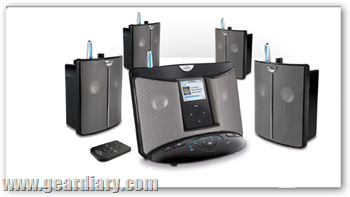
All right, so what are we talking about here? Basically, there are two components to the Eos Wireless system: the base station and the satellite speakers. Just plug your iPod or other portable media player into the base station (the base station has speakers of its own as well.) Now, just take the satellite speakers and arrange them throughout the house. Anywhere you want to hear music, just place a speaker.
Once you have the speakers arranged, crank the tunes. That’s it! The EOS Wireless utilizes and impressive GigaWave Wireless system, which can transmit your music to up to four satellite speakers at once. I was very impressed by the range of these system. While Bluetooth could extend for about 30 feet before it starts to experience problems, the Eos GigaWave system utilizes 1.5 Mbps transmission rate, which can extend 150 feet indoors and 300 feet outdoors. Now, I will admit that I did not take a ruler with me to test this. I just took their word on the advertised distances. I can tell you, however, that with the base unit in the family room, I could place the speakers in any room in my house (including the basement) or in the outside areas around my house, with no problems.
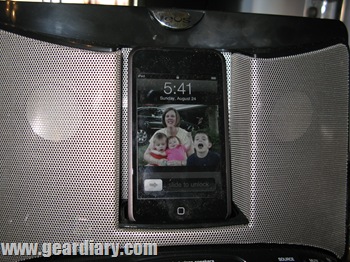
Base Station: The base station is the main unit for the EOS system. As an initial matter, I was really impressed by how compact this unit was. The entire face consists of two speakers, which project music into the main room where the unit it located. Between the two speakers is the iPod dock. Just plug your iPod into this dock and you are ready to go. The package does include adaptors for a variety of different iPods, in order to ensure that it lines up correctly.
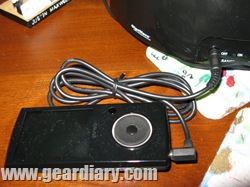
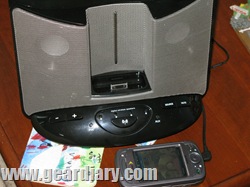
If you do not have an iPod, the EOS speakers are also compatible with pretty much any media player. Just plug the included audio cable into the headphone or audio out jack, and then into the auxiliary port on the back. I had a little trouble with this, only because the location of the auxiliary port was not well documented at all. Additionally using the auxiliary port was simple less elegant than the iPod dock. Rather than having the nice clean lines of an iPod filling the gap in the front, you are left with a gaping hole where the iPod should dock, and a media player dangling off the back of the EOS. Functional, but not very attractive.
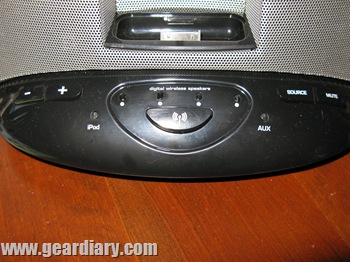
The controls are really pretty simple. Selecting your track and play/pause is still all done through your iPod or media player. A blue light on the base will show which input you are using (tap the source button to switch between the iPod and Aux input.) I was a bit disappointed to find, however, that the base station does not take over control of your iPod. The only iPod control which is taken over by the base station is the volume control. Use the large buttons on the left or the mute button to control the volume.
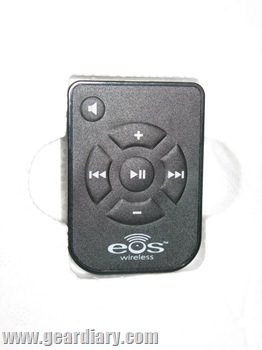
You may also choose to use the included remote control to control your music. Unlike the main base station, the remote control will control your iPod. It will not, however, take over control of a media player connected to the auxiliary input. This means you can quickly and easily control your music from anywhere in the room.
Once you have your ipod or media player setup and ready to play, it is time to connect to your external speakers. Just arrange them throughout your home. A blue light on the base station antenna will indicate that it is transmitting. The base station will then find and connect to the speakers and begin transmitting music. Lights on the front of the base station will indicate how many speakers are connected wirelessly to the base station. This really could not have been any easier. Unlike Bluetooth which can involve a complicated or frustrating pairing and connection process, this was a piece of cake. With the press of just one button, the speakers connect wirelessly and immediately begin playing your music.
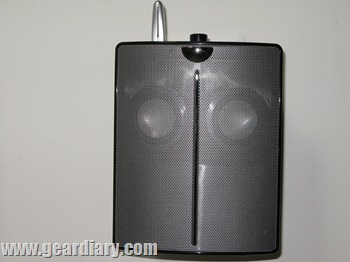
Satellite Speakers: OK. Here is where things get really interesting. Without the satellite speakers, this would really be a pretty nice sounding speaker dock. With the satellite speakers….well, let’s just go ahead and take a look.
The first thing I noticed was the size of these speakers. At 9 inches tall, they are pretty compact, and can fit just about anywhere. Like the base unit, an antenna sticks off the top. This serves two purposes. First, it helps the speaker receive the signal. Additionally, the blue light shows whether it is actually connected to the base unit. Blinking blue means it is searching for a signal. Solid blue means it is connected.
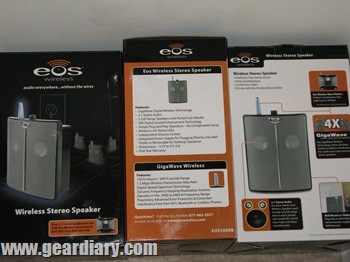
Each speaker includes two full range drivers and a seperate subwoofer for 2.1 stereo sound in each speaker. The satellite speakers also each have a separate power and volume control. This is both good and bad. On one hand, you can control the sound coming from each speaker individually, allowing you to make it louder in one location and softer in another. On the other hand, it would be nice to be able to control the volume of the satellite speakers all from one location. I quickly learned that the volume controls on the base station control only the volume of the base station. It would be nice if the base station also included controls for each speaker.
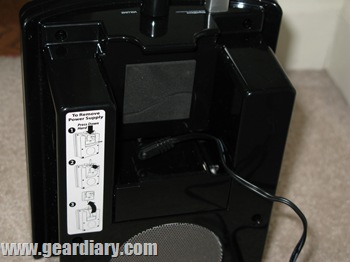
In the back of the speaker, you will find the plug, which stores safely tucked into the speaker. Just pull it out, unravel the cord, and plug it into the wall. Or, leave it connected and the speaker will hang from the outlet. I was a bit disappointed that there was no option to use batteries in these speakers. It was a bit limiting to have to place them near an outlet.
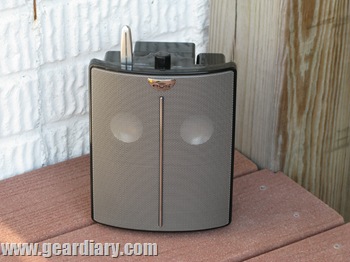
How do they work: This brings us to the real question for any wireless device. Does it work as advertised? Before, we get there, a note on how I tested. I utilized both the iPod connection and the auxiliary connections with my iPod Touch, Sandisk Sansa View, and Sprint Mogul. The package included one satellite speaker, and EOS was kind enough to send three more, giving me the maximum compliment of four speakers. I arranged the speakers as follows:
- Base Station: In the family room. First floor, rear of the house
- Speaker 1: Foyer. First floor, front of the house
- Speaker 2: Bedroom. Second Floor, front of the house
- Speaker 3: Bedroom. Second Floor, rear of the house
- Speaker 4: Back patio.
This arrangement was about as much as I could spread out the speakers. It included three different levels of the house, both indoors and outdoors, and arrangements in the front and rear of the house. Short of placing a speaker in my neighbor’s house (which I suspect would have worked,) this was as far apart as I could have placed the speakers.
So, we fired them up and boy were we impressed. The boys liked these speakers so much, we had to have a mini-traveling concert, playing our drums and guitars along with each of the four speakers. The sound was incredible from all of the speakers, even those which were located further away, and outside. There was absolutely no sign that these speakers were wireless. The sound quality was crystal clear. No pops. No crackles. Not even a snap. And certainly none of the telltale skips that I typically find with Bluetooth headphones. Eos did a fantastic job with the error control on this one. That being said, the speakers did tend to favor the mid-ranges. Audiophiles out there will note that, while these speakers serve a specific function, they are not designed to replace your high end stereo speakers. Still, I thought they sounded great, particularly when used as intended to supplement your primary speaker system at parties and other gatherings.
Conclusion: I really wish these speakers had been around when I was in college. It is the perfect solution for transmitting music simultaneously throughout your house. The base station, and each of the speakers are compact and easy to connect and control. The best part, however, was the sound quality, which was great, especially if you plan to use these speakers as they were intended in the background of a large gathering or party. Next time you have a party, you will definitely want to give these a look…or better yet, a listen.
What I Like: Compact speakers. Great sound and wireless connection. Easy to use controls.
What Needs Improvement:No speaker controls on the base station. There should be an option use battery power for increased flexibility in speaker placement.
Where To Buy: Eos Wireless
Price: Base Station (includes one speaker) $249.95
Additional speakers $129.95
Full System (base station and four speakers) $639.80

This is not a bad price when you consider that to connect my upstairs radio to iTunes I purchased an Airport Express for $100 — only about $30 cheaper than additional speakers and that solution required me to supply my own radio and cabling.
Yeah, I agree, Wayne. The price is not terrible for all you get. I still think it is a bit on the high side. I would like to see the base station comein under $200 and the speakers under $100. That way, you could get the whole system for $500.
DOug